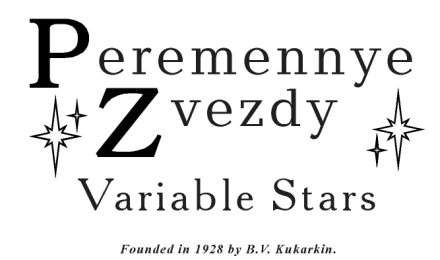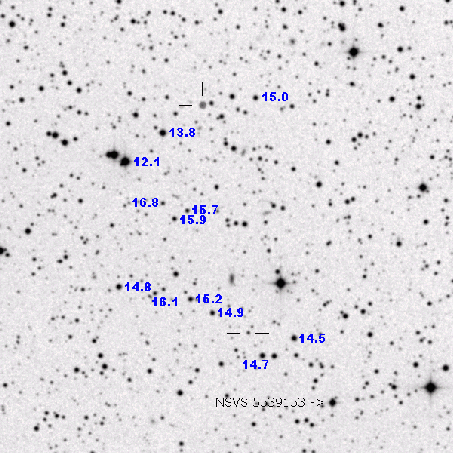|
Peremennye Zvezdy (Variable Stars) 31, No. 3, 2011 Received 20 July; accepted 12 August.
|
Article in PDF |
Two New Cataclysmic Variables in Lyra
D. V. Denisenko
Space Research Institute, Moscow, Russia; e-mail: denis@hea.iki.rssi.ru
|
I report on the discovery of two cataclysmic variables
in the same field in Lyra, originally identified on the base of
their magnitudes in the USNO-B1.0 catalog and on Palomar images.
The historical light curves were analyzed from 300+ photographic
plates of the Moscow collection, covering 35 years of
observations. One of the two stars, USNO-B1.0 1320-0390658, is
showing rather frequent outbursts from |
In the course of my search for new cataclysmic variables, I found
the star USNO-B1.0 1320-0390658 (19![]() 21
21![]() 44
44![]() 232,
+42
232,
+42![]() 04
04![]() 41
41
![]() 81, J2000.0) showing strong variability
between the two Palomar epochs:
81, J2000.0) showing strong variability
between the two Palomar epochs: ![]() ,
, ![]() ,
,
![]() ,
, ![]() ,
, ![]() . Since the star's position is
where three POSS-II fields overlap, three second-epoch plates are
available for each band (blue, red and infrared), along with two
first-epoch red plates and two Quick-
. Since the star's position is
where three POSS-II fields overlap, three second-epoch plates are
available for each band (blue, red and infrared), along with two
first-epoch red plates and two Quick-![]() photovisual plates. The
star was just outside the field of view of the first-epoch blue
plate taken on 1951 September 2.
photovisual plates. The
star was just outside the field of view of the first-epoch blue
plate taken on 1951 September 2.
The variable was at outburst on the 1991 September 6 plate and in
quiescence on all the remaining 13 plates. Fortunately, the
![]() magnitude for the USNO-B1.0 catalog was measured from the 1991
plate. The comparison of fragments of the 1991 and 1995 red
plates, centered at the new variable, is shown in Fig. 1.
magnitude for the USNO-B1.0 catalog was measured from the 1991
plate. The comparison of fragments of the 1991 and 1995 red
plates, centered at the new variable, is shown in Fig. 1.
While examining the Palomar plates of this field, I
serendipitously found another variable in about 5![]() to the
north of the first one, with a bright outburst on the 1993 June 11
infrared plate. This star also enters the USNO-B catalog as
USNO-B1.0 1321-0397655, with the following coordinates and
individual magnitudes: 19
to the
north of the first one, with a bright outburst on the 1993 June 11
infrared plate. This star also enters the USNO-B catalog as
USNO-B1.0 1321-0397655, with the following coordinates and
individual magnitudes: 19![]() 21
21![]() 48
48![]() 934,
+42
934,
+42![]() 09
09![]() 46
46
![]() 60 (J2000.0),
60 (J2000.0), ![]() ,
, ![]() ,
,
![]() ,
, ![]() ,
, ![]() . The comparison of 1993 June 11
and June 30 infrared plates centered at the second variable is
shown in Fig. 2.
. The comparison of 1993 June 11
and June 30 infrared plates centered at the second variable is
shown in Fig. 2.
The image of the star in outburst was carefully examined to prove
it was not an artifact. It has the same profile as those of other
stars of similar brightness. The formal image characteristics
(FWHM![]() , flatness
, flatness![]() , maximum pixel value
, maximum pixel value![]() ) are
matching other stars in the 11-13
) are
matching other stars in the 11-13![]() range. Even the profile
asymmetry is the same (the top of the Gaussian is tilted to the
west for all overexposed stars, including the variable). Finally,
the coordinates of the star in the June 11 plate are identical to
those measured from all other images, within the astrometric
uncertainties (0.1-0.2
range. Even the profile
asymmetry is the same (the top of the Gaussian is tilted to the
west for all overexposed stars, including the variable). Finally,
the coordinates of the star in the June 11 plate are identical to
those measured from all other images, within the astrometric
uncertainties (0.1-0.2
![]() for different plates). This perfect
match makes it extremely unlikely for the brightening to result
from a chance alignment of the star with a satellite glint or from
any other phenomenon, be it natural or artificial.
for different plates). This perfect
match makes it extremely unlikely for the brightening to result
from a chance alignment of the star with a satellite glint or from
any other phenomenon, be it natural or artificial.
The
![]() finder chart, with the positions of
both variables indicated, is presented in Fig. 3. The first
variable is marked with two horizontal dashes and the second one,
with a horizontal dash and a vertical dash. Neither of the stars
is present in the AAVSO Variable Star Index (VSX; Watson et al.,
2006); the nearest variable listed there is NSVS 5539153
(19
finder chart, with the positions of
both variables indicated, is presented in Fig. 3. The first
variable is marked with two horizontal dashes and the second one,
with a horizontal dash and a vertical dash. Neither of the stars
is present in the AAVSO Variable Star Index (VSX; Watson et al.,
2006); the nearest variable listed there is NSVS 5539153
(19![]() 21
21![]() 34
34![]() 67, +42
67, +42![]() 03
03![]() 03
03
![]() 1, J2000.0), which is
an EW eclipsing variable with
1, J2000.0), which is
an EW eclipsing variable with
![]() . The position of
NSVS 5539153 is marked in the chart by an arrow. Also shown are
blue (USNO-A2.0) magnitudes of the comparison stars used to
estimate the new variables using Moscow archival plates.
. The position of
NSVS 5539153 is marked in the chart by an arrow. Also shown are
blue (USNO-A2.0) magnitudes of the comparison stars used to
estimate the new variables using Moscow archival plates.
Following the numbering scheme introduced back in 2007, the new
variables were designated DDE 20 and DDE 21, using the AAVSO
observer code of the author. The list of variables discovered by
DDE with their coordinates, finder charts and references is
available online at
http://hea.iki.rssi.ru/![]() denis/VarDDE.html.
denis/VarDDE.html.
The magnitudes of the variables measured from Palomar plates are
collected in Table 1. The brightest magnitudes detected for each
of the stars are printed in boldface. It is notable that DDE 21
was fading after the outburst in June 1993. Its brightness in the
June 24 red plate was
![]() above the quiescent level. Such
fading is consistent with outbursts of the WZ Sge dwarf novae,
with typical outburst amplitudes about 7.5
above the quiescent level. Such
fading is consistent with outbursts of the WZ Sge dwarf novae,
with typical outburst amplitudes about 7.5![]() . However, a
recurrent nova outburst also cannot be ruled out.
. However, a
recurrent nova outburst also cannot be ruled out.
To search for possible past outbursts, I checked the existing
photographic plates of the Sternberg Astronomical Institute (SAI),
Moscow University (the Moscow plate collection, Samus et al.
2006). The new variables are inside the
![]() FOVs
of three areas regularly photographed with the 40-cm astrograph of
the SAI's Crimean Laboratory, the typical exposure times being
45-60 minutes (10-30 minutes in some exceptional cases).
Depending on sky conditions, exposure times, and image quality,
the limiting magnitudes of these plates vary in a wide range,
being sometimes as good as 17.5, but typically between 16.5 and
17.0. In total, I examined 315 plates.
FOVs
of three areas regularly photographed with the 40-cm astrograph of
the SAI's Crimean Laboratory, the typical exposure times being
45-60 minutes (10-30 minutes in some exceptional cases).
Depending on sky conditions, exposure times, and image quality,
the limiting magnitudes of these plates vary in a wide range,
being sometimes as good as 17.5, but typically between 16.5 and
17.0. In total, I examined 315 plates.
Eleven plates taken in August 1957 centered at 1906+38.5 were not
usable for estimating DDE 20 since they had 10-minute exposures
and the limiting magnitudes of 15![]() . The variables were outside
the FOV of 4 plates; 7 plates are of poor quality. All the
remaining plates were usable, even though the variables were
located just 1.5 cm north and 3.5 cm west of the corner of one of
the fields (the plate size is
. The variables were outside
the FOV of 4 plates; 7 plates are of poor quality. All the
remaining plates were usable, even though the variables were
located just 1.5 cm north and 3.5 cm west of the corner of one of
the fields (the plate size is ![]() cm
cm![]() ).
).
In total, eight outbursts of DDE 20 were found using these plates,
with the maximum brightness of ![]() . Three of these outbursts
have good coverage, with 5-10 available plates taken during
several nights, while the other five outbursts were detected each
on one plate only, due to gaps in observations. The entire light
curve of DDE 20 is shown in Fig. 4; the gray triangles are upper
limits (rounded to 0.5
. Three of these outbursts
have good coverage, with 5-10 available plates taken during
several nights, while the other five outbursts were detected each
on one plate only, due to gaps in observations. The entire light
curve of DDE 20 is shown in Fig. 4; the gray triangles are upper
limits (rounded to 0.5![]() ). Since the magnitudes of the variable
in outburst were estimated by visual inspection, typical errors
are 0.1-0.2
). Since the magnitudes of the variable
in outburst were estimated by visual inspection, typical errors
are 0.1-0.2![]() . Figure 5 shows the well-covered outburst of April
1968 in more detail.
. Figure 5 shows the well-covered outburst of April
1968 in more detail.
The outburst dates of DDE 20 are listed in Table 2. The intervals between the outbursts and their durations most likely correspond to a dwarf nova of the SS Cyg subtype (UGSS); however, the SU UMa (UGSU) classification is also possible.
Moscow plates reveal no additional outbursts of USNO-B1.0
1321-0397655 = DDE 21. Unfortunately, no plates are available
between 1991 May 23 and 1995 July 27. The 2MASS infrared images
were also checked. The ![]() images were taken on 1998 June 8,
nothing is visible at the position of the variable down to the
limiting magnitude (
images were taken on 1998 June 8,
nothing is visible at the position of the variable down to the
limiting magnitude (![]() ). Together with the USNO-B1.0
). Together with the USNO-B1.0 ![]() and
and ![]() magnitudes (the
magnitudes (the ![]() color index is formally 1.3-1.6)
and the star's being faint on two POSS IR plates, this excludes
the possibility of DDE 21 being a red flaring star. As it was
already mentioned above, this variable is a likely representative
of WZ Sge dwarf novae or even of a still rarer class of recurrent
novae. Objects of both types are typically undergoing outbursts
once in 20-30 years. Thus, DDE 21 may be on the way to its next
outburst that can happen at any time in the nearest future. A
monitoring campaign of these two objects, located within just
color index is formally 1.3-1.6)
and the star's being faint on two POSS IR plates, this excludes
the possibility of DDE 21 being a red flaring star. As it was
already mentioned above, this variable is a likely representative
of WZ Sge dwarf novae or even of a still rarer class of recurrent
novae. Objects of both types are typically undergoing outbursts
once in 20-30 years. Thus, DDE 21 may be on the way to its next
outburst that can happen at any time in the nearest future. A
monitoring campaign of these two objects, located within just
![]() from each other, is encouraged.
from each other, is encouraged.
Acknowledgments: I would like to thank N.N. Samus, S.V. Antipin, and E.V. Kazarovets for their long-time assistance in my work with the Moscow plate collection and useful discussions.
| Date | Band | DDE 20 | DDE 21 |
| 1951 July 09 | Red | 19.14 | 19.14 |
| 1951 July 09 | Blue | 18.92 | 19.75 |
| 1951 Sep 02 | Red | 18.97 | 18.49 |
| 1982 May 23 | 18.87 | ||
| 1982 May 23 | 19.10 | 18.72 | |
| 1988 July 09 | Blue | 20.25 | 18.94 |
| 1989 July 04 | Blue | 20.80 | 19.29 |
| 1990 July 18 | Blue | 20.11 | 19.49 |
| 1991 Sep. 06 | Red | 15.87 | 18.92 |
| 1992 May 28 | IR | 18.20 | |
| 1993 June 11 | IR | 18.61 | 11.75 |
| 1993 June 24 | Red | 19.32 | 17.54 |
| 1993 June 30 | IR | 17.95 | |
| 1995 June 20 | Red | 19.27 | 18.36 |
| Plate No. | Date | Time, | Exp. | Mag |
| yyyy.mm.dd | UT | (min) | ||
| A05404 | 1967.08.11 | 17:54.0 | 45 | 16.1: |
| A05405 | 1967.08.11 | 18:43.0 | 45 | 16.0: |
| A05406 | 1967.08.11 | 19:29.0 | 45 | 16.1: |
| A05407 | 1967.08.11 | 20:15.0 | 45 | 15.9: |
| A05408 | 1967.08.11 | 21:01.0 | 45 | 16.2: |
| A05409 | 1967.08.12 | 18:24.0 | 45 | 15.2 |
| A05410 | 1967.08.12 | 19:10.0 | 45 | 15.3 |
| A05411 | 1967.08.12 | 19:56.0 | 45 | 15.4 |
| A05412 | 1967.08.12 | 20:42.0 | 45 | 15.6 |
| A05413 | 1967.08.12 | 21:28.0 | 45 | 15.5: |
| A05751 | 1968.04.18 | 18:08.7 | 30 | 15.5: |
| A05755 | 1968.04.18 | 20:41.7 | 30 | 15.3 |
| A05766 | 1968.04.19 | 19:56.0 | 40 | 15.4 |
| A05767 | 1968.04.19 | 20:42.6 | 30 | 15.4 |
| A05781 | 1968.04.21 | 20:01.5 | 30 | 15.9 |
| A05782 | 1968.04.21 | 20:38.0 | 20 | 15.9 |
| A05795 | 1968.04.22 | 20:58.1 | 35 | 16.3 |
| A05796 | 1968.04.22 | 21:40.1 | 20 | 16.1 |
| A05805 | 1968.04.23 | 21:23.0 | 30 | 16.5: |
| A05806 | 1968.04.23 | 21:55.0 | 30 | 16.5: |
| A06072 | 1968.09.17 | 17:05.0 | 47 | 15.8 |
| A14464 | 1981.08.22 | 20:14.0 | 48 | 15.3 |
| A15695 | 1983.08.04 | 21:16.1 | 60 | 15.5: |
| A16310 | 1984.05.03 | 20:42.3 | 45 | 15.2 |
| A16311 | 1984.05.03 | 21:32.7 | 45 | 15.4 |
| A16312 | 1984.05.03 | 22:23.6 | 45 | 15.3 |
| A16313 | 1984.05.03 | 23:12.8 | 45 | 15.2 |
| A18383 | 1988.05.13 | 22:09.4 | 60 | 15.2: |
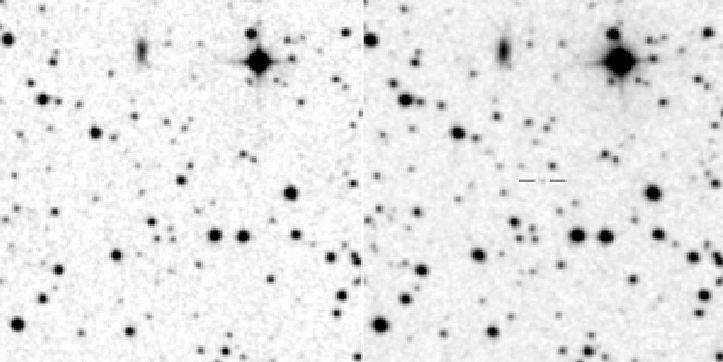 |
Fig. 1.
USNO-B1.0 1320-0390658 (DDE 20) on the red
DSS plates taken on 1991 September 6 (left) and on 1995 June 20
(right). The FOV is
|
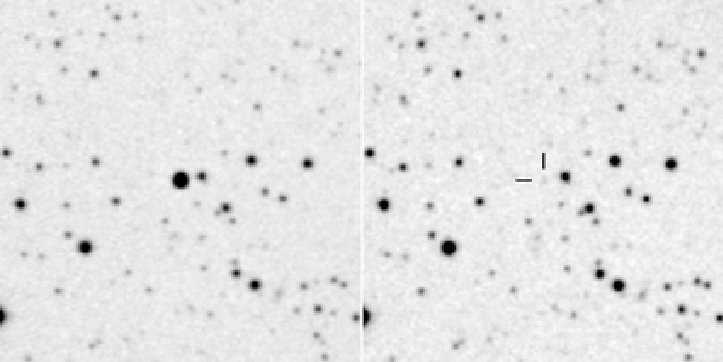 |
Fig. 2.
USNO-B1.0 1321-0397655 (DDE 21) on the
infrared DSS plates taken on 1993 June 11 (left) and on 1993 June
30 (right). The FOV is
|
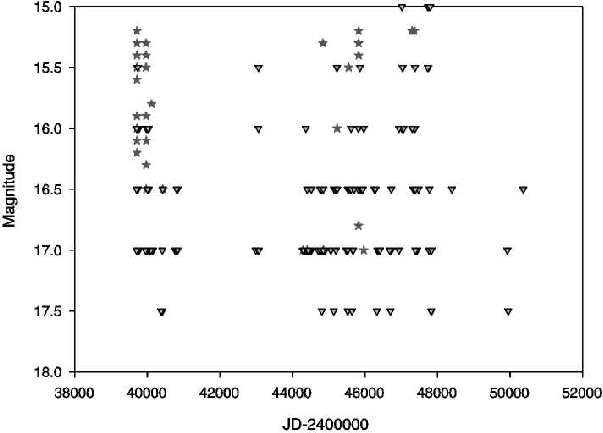 |
Fig. 4. The light curve of DDE 20 from Moscow photographic plates. Asterisks are positive detections and triangles, plate limits. |
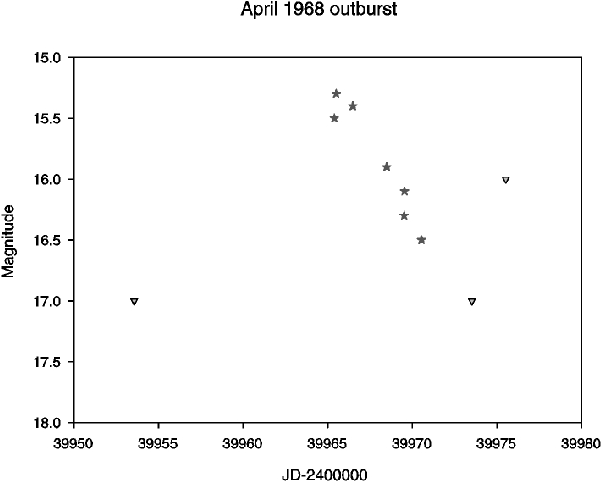 |
Fig. 5. The light curve for the April 1968 outburst of DDE 20 from Moscow photographic plates. The symbols are the same as in Fig. 4. |
References:
Samus, N.N., Sat, L.A., Vereshchagin, S.V., Zharova, A.V., 2006, in Virtual Observatory: Plate Content Digitization, Archive Mining and Image Sequence Processing, Proceedings of the iAstro Workshop, Sofia, Bulgaria, M. Tsvetkov, V. Golev, F. Murtagh, R. Molina (eds.), Sofia: Heron Press Ltd., p. 103
Watson, C.L., Henden, A.A., Price, A., 2006, in The Society for Astronomical Sciences 25th Annual Symposium on Telescope Science, Big Bear, CA, B.D. Warner, J.L. Foote, D. Mais, D. Kenyon (eds.), p. 47
